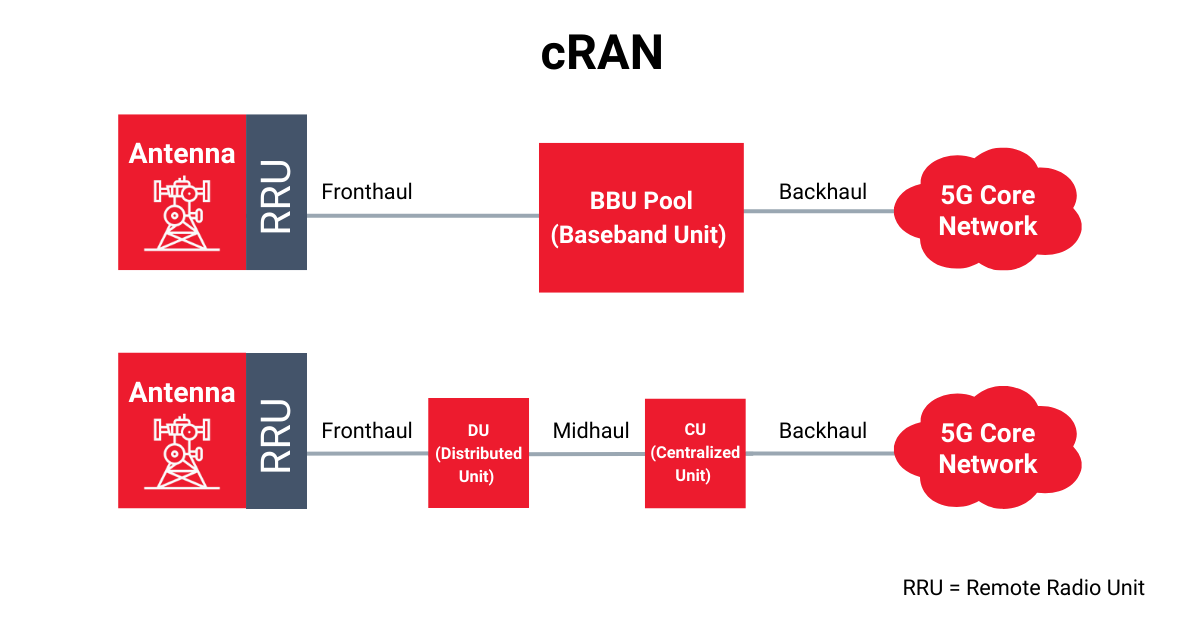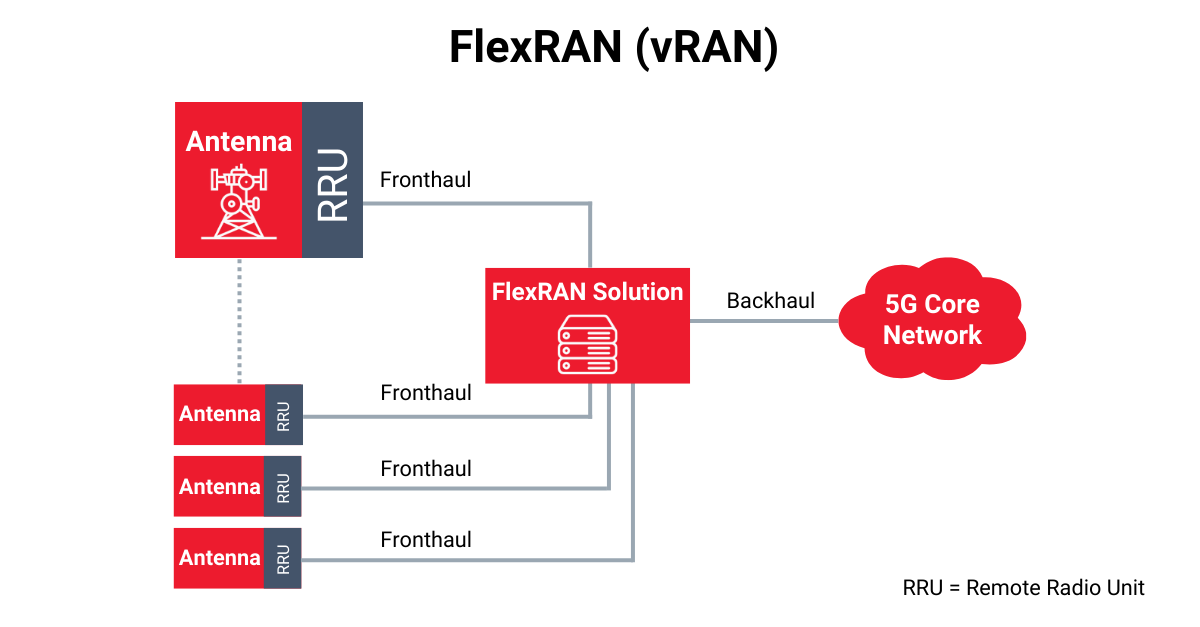Share this
What is Intel® FlexRAN?
by Christopher Trick on Aug 22, 2022 3:52:35 PM
The amount of available data has exploded, increasing demands on networks to quickly process, analyze, and forward this data. Current network architectures, however, are insufficient to handle such workloads.
In the blog, you'll learn what Intel® FlexRAN is and how it helps make vRAN more flexible and efficient to enhance networking capabilities with minimal hardware usage.
Before we get into FlexRAN, let's recap what RAN is.
A RAN (radio access network) is a type of network infrastructure used commonly for mobile networks that consist of radio base stations with large antennas.
The primary purpose of a RAN is to wirelessly connect user equipment.
To learn all about the different variations of RAN, click here.
What is Intel® FlexRAN?
Traditional RAN architectures, also known as D-RAN (distrusted RAN) or C-RAN (centralized RAN) are not enough to meet the demands of the modern technological landscape.
The image below shows how a traditional cRAN architecture is structured:

5G networks are having to handle increasing amounts of data from millions of interconnected devices on a daily basis. In addition, 5G networks require more visibility, automation, and adaptability that hardware-based RANs cannot provide.
To accommodate this, networks must evolve to possess the bandwidth necessary to process data in real-time. This means that the core network must be transformed from fixed-function hardware to an open, software-based platform, also known as vRAN (virtualized RAN).
vRANs adapt much quicker and allow changes without replacing hardware, only needing software updates. Often, this requires just minor modifications to COTS (commercial-off-the-shelf) hardware.
Enter Intel® FlexRAN, a fully virtual and cloud-native type of vRAN that streamlines resource use and separates network functions from underlying hardware. A single piece of hardware is used across the network, the RAN, and the edge, reducing costs and increasing flexibility.
This is done primarily by separating control planes--which control how data is forwarded--and data planes--which actually forward the data, helping to ensure a flexible, cost-effective, and dynamic RAN environment.
The image below shows how FlexRAN enhances and streamlines previous RAN architectures:

FlexRAN is powered by 3rd Gen Intel® Xeon® Scalable Processors, bringing high efficiency into vRAN technology through increased throughput and built-in AI-acceleration.
These processors are enhanced with the AVX-512 parallel instruction set, as well as NFVI and DPDK technologies, and they can run on Wind River Titanium Cloud.
FlexRAN's flexibility is further enhanced through O-RAN (OpenRAN), which supports interoperation between different vendors' equipment. This arose in part because of the demands of operators to have a more diverse ecosystem of vendors from which to chose to construct their RAN architectures.
Let's take a look at how FlexRAN actually works:
How does FlexRAN work?
FlexRAN is made up of two main components: the FlexRAN Control Plane and the FlexRAN Agent API.
The FlexRAN Control Plane is hierarchical in nature. At the top is a master controller that is connected to a number of FlexRAN agents, one for each base station, also known as an edge node. (This is where rack servers, like Trenton's BAM servers, can come into play.)
The FlexRAN Agent API (Application Programming Interface) separates the FlexRAN Agent, which is the control plane, and the eNodeB (edge node), which is the data plane.
The FlexRAN protocol facilitates communication between the master controller and the agents.
Below demonstrates how a FlexRAN architecture is structured:
What are the primary features of FlexRAN?
There are four primary features of FlexRAN: control and data plane separation, centralized and real-time control, virtualized control functions, and control delegation and policy reconfiguration.
Let's take a look at each one:
Control and data plane separation
FlexRAN separates the RAN control and data planes.
This has two major benefits. First, this reduces the complexity of developing new control solutions. Second, this encourages openness and innovation by allowing operations to open up their RAN architectures to legitimate, authorized third parties, so they can deploy new applications and services.
Centralized and real-time control
FlexRAN consolidates the control plane into one locally centralized controller. This enables easier coordination among base stations, simplifying the development of more sophisticated control applications.
Additionally, FlexRAN is designed in a way that enables the deployment of real-time control applications with strict time constraints.
Virtualized control function
FlexRAN allows the flexible and programmable control of the underlying RAN infrastructure through using a number of modular, virtualized control functions with well-defined interfaces.
These control functions are responsible for performing various control operations of the base station; they allow the system to be easily upgraded by replacing or extending the corresponding function without affecting the rest of the system.
Control delegation and policy reconfiguration
The virtualized control functions of FlexRAN are exploited through a set of mechanisms designed to allow the transfer of control functions from the master controller to the base stations at run time as well as the simple, seamless reconfiguration of their behavior and parameters in real-time.
This helps to make the system flexible and adaptable to underlying network conditions and specific requirements of the network operator.
Intel® FlexRAN Use Cases
Within the military sector, FlexRAN, coupled with 5G technology, enables prompt, data-driven decisions by military commanders across all operational domains with greater connectivity, faster and more reliable networks, and new data capabilities.
FlexRAN can help manage huge amounts of data generated by sensors and devices, bringing compute capabilities to the edge across a wide range of applications.
Let's take a look at three:
Electronic warfare (EW)
Electronic warfare (EW) involves interconnected devices on land or in the air using the electromagnetic spectrum to attack adversary forces or preventing them from taking control of these signals.
All the signals that are generated, however, need to be processed in a matter of seconds. The slightest delay can mean not deflecting an attack or even allowing adversaries to take control of the spectrum, which can put warfighters in a life-threatening situation.
FlexRAN helps ensure that all data is quickly communicated between devices in real-time, effectively deterring adversary threats and preventing them from gaining control.

C6ISR
C6ISR involves devices gathering, processing, analyzing, and distributing intelligence from a network of sensors, whether on the ground or in the air.
But this data must be sent back to a command room at lightning speed, so it can be used to gain a better understanding of adversary and environment, thus shortening response times.
Through increasing data processing and analytics capabilities, FlexRAN can quickly deliver the mission-critical insights necessary to detect, track, and engage with enemy threats.

Signal intelligence (SIGINT)
Signal intelligence (SIGINT) involves using intelligence gathered from electronic signals and systems used by foreign targets--communications systems, radar, and weapons systems--that provide insight into an adversary's capabilities, actions, and intentions.
These signals must be instantly communicated and readily available in order to help warfighters gain a competitive advantage. A single undetected or slowly delivered signal can mean missing an adversary's next move, putting lives at risk.
FlexRAN equips computers with the ability to detect multiple radar signals simultaneously in unprecedented bandwidth to effectively deter adversaries' attacks.

Intel® FlexRAN and Trenton's IES 5G Solution
Equipped with FlexRAN, the IES.5G uses virtualized RAN architectures to strengthen communications and data flow to support mission-critical applications with constantly expanding complex computing requirements.
Each server within the IES 5G is equipped with Intel® 3rd Gen Xeon® Scalable Processors and DDR4-3200 DIMM slots to increase throughput and provide maximum memory support to the CPU, helping to run multiple vRANs at a time. To accelerate vRAN applications, each server can also be equipped with Intel® vRAN Accelerator ACC100 adapters.
At its core, the IES 5G helps enhance networking capabilities by minimizing the use of expensive hardware without loss of performance.

Final thoughts
A key component of high-performance computing architectures is the ability to instantly gather, process, analyze, and distribute data across a network to a web of interconnected devices in real-time.
Traditional RAN architectures have relied heavily on expensive hardware to forward data to a core network, which hampers efficiency and increases costs.
As the amount of available data increases, however, so does the need for advanced networking technologies to meet the ever-evolving demands of the modern technological landscape.
FlexRAN provides a flexible, cost-effective alternative, allowing multiple, virtualized RANs to run on the same piece of hardware. This simplifies network management and enables implementation only when and where required.
Trenton's IES.5G solution is integrated with Intel® FlexRAN to enhance networking capabilities and data transfer rates to fortify mission-critical applications in real-time at the tactical edge.
With FlexRAN's reference design and O-RAN industry and ecosystem collaboration, the military, commercial, and industrial sectors are equipped with an agile future-proof platform to accelerate innovation across a wide range of environments and applications.
Interested in learning more about 5G? Check out some other key 5G technologies that enhance compute architectures here.
Source:Share this
- High-performance computers (42)
- Military computers (38)
- Rugged computers (32)
- Cybersecurity (25)
- Industrial computers (25)
- Military servers (24)
- MIL-SPEC (20)
- Rugged servers (19)
- Press Release (17)
- Industrial servers (16)
- MIL-STD-810 (16)
- 5G Technology (14)
- Intel (13)
- Rack mount servers (12)
- processing (12)
- Computer hardware (11)
- Edge computing (11)
- Rugged workstations (11)
- Made in USA (10)
- Partnerships (9)
- Rugged computing (9)
- Sales, Marketing, and Business Development (9)
- Trenton Systems (9)
- networking (9)
- Peripheral Component Interconnect Express (PCIe) (7)
- Encryption (6)
- Federal Information Processing Standards (FIPS) (6)
- GPUs (6)
- IPU (6)
- Joint All-Domain Command and Control (JADC2) (6)
- Server motherboards (6)
- artificial intelligence (6)
- Computer stress tests (5)
- Cross domain solutions (5)
- Mission-critical servers (5)
- Rugged mini PCs (5)
- AI (4)
- BIOS (4)
- CPU (4)
- Defense (4)
- Military primes (4)
- Mission-critical systems (4)
- Platform Firmware Resilience (PFR) (4)
- Rugged blade servers (4)
- containerization (4)
- data protection (4)
- virtualization (4)
- Counterfeit electronic parts (3)
- DO-160 (3)
- Edge servers (3)
- Firmware (3)
- HPC (3)
- Just a Bunch of Disks (JBOD) (3)
- Leadership (3)
- Navy (3)
- O-RAN (3)
- RAID (3)
- RAM (3)
- Revision control (3)
- Ruggedization (3)
- SATCOM (3)
- Storage servers (3)
- Supply chain (3)
- Tactical Advanced Computer (TAC) (3)
- Wide-temp computers (3)
- computers made in the USA (3)
- data transfer (3)
- deep learning (3)
- embedded computers (3)
- embedded systems (3)
- firmware security (3)
- machine learning (3)
- Automatic test equipment (ATE) (2)
- C6ISR (2)
- COTS (2)
- COVID-19 (2)
- CPUs (2)
- Compliance (2)
- Compute Express Link (CXL) (2)
- Computer networking (2)
- Controlled Unclassified Information (CUI) (2)
- DDR (2)
- DDR4 (2)
- DPU (2)
- Dual CPU motherboards (2)
- EW (2)
- I/O (2)
- Military standards (2)
- NVIDIA (2)
- NVMe SSDs (2)
- PCIe (2)
- PCIe 4.0 (2)
- PCIe 5.0 (2)
- RAN (2)
- SIGINT (2)
- SWaP-C (2)
- Software Guard Extensions (SGX) (2)
- Submarines (2)
- Supply chain security (2)
- TAA compliance (2)
- airborne (2)
- as9100d (2)
- chassis (2)
- data diode (2)
- end-to-end solution (2)
- hardware security (2)
- hardware virtualization (2)
- integrated combat system (2)
- manufacturing reps (2)
- memory (2)
- mission computers (2)
- private 5G (2)
- protection (2)
- secure by design (2)
- small form factor (2)
- software security (2)
- vRAN (2)
- zero trust (2)
- zero trust architecture (2)
- 3U BAM Server (1)
- 4G (1)
- 4U (1)
- 5G Frequencies (1)
- 5G Frequency Bands (1)
- AI/ML/DL (1)
- Access CDS (1)
- Aegis Combat System (1)
- Armed Forces (1)
- Asymmetric encryption (1)
- C-RAN (1)
- COMINT (1)
- Cloud-based CDS (1)
- Coast Guard (1)
- Compliance testing (1)
- Computer life cycle (1)
- Containers (1)
- D-RAN (1)
- DART (1)
- DDR5 (1)
- DMEA (1)
- Data Center Modular Hardware System (DC-MHS) (1)
- Data Plane Development Kit (DPDK) (1)
- Defense Advanced Research Projects (DARP) (1)
- ELINT (1)
- EMI (1)
- EO/IR (1)
- Electromagnetic Interference (1)
- Electronic Warfare (EW) (1)
- FIPS 140-2 (1)
- FIPS 140-3 (1)
- Field Programmable Gate Array (FPGA) (1)
- Ground Control Stations (GCS) (1)
- Hardware-based CDS (1)
- Hybrid CDS (1)
- IES.5G (1)
- ION Mini PC (1)
- IP Ratings (1)
- IPMI (1)
- Industrial Internet of Things (IIoT) (1)
- Industry news (1)
- Integrated Base Defense (IBD) (1)
- LAN ports (1)
- LTE (1)
- Life cycle management (1)
- Lockheed Martin (1)
- MIL-S-901 (1)
- MIL-STD-167-1 (1)
- MIL-STD-461 (1)
- MIL-STD-464 (1)
- MOSA (1)
- Multi-Access Edge Computing (1)
- NASA (1)
- NIC (1)
- NIC Card (1)
- NVMe (1)
- O-RAN compliant (1)
- Oil and Gas (1)
- Open Compute Project (OCP) (1)
- OpenRAN (1)
- P4 (1)
- PCIe card (1)
- PCIe lane (1)
- PCIe slot (1)
- Precision timestamping (1)
- Product life cycle (1)
- ROM (1)
- Raytheon (1)
- Remotely piloted aircraft (RPA) (1)
- Rugged computing glossary (1)
- SEDs (1)
- SIM Card (1)
- Secure boot (1)
- Sensor Open Systems Architecture (SOSA) (1)
- Small form-factor pluggable (SFP) (1)
- Smart Edge (1)
- Smart NIC (1)
- SmartNIC (1)
- Software-based CDS (1)
- Symmetric encryption (1)
- System hardening (1)
- System hardening best practices (1)
- TME (1)
- Tech Partners (1)
- Total Memory Encryption (TME) (1)
- Transfer CDS (1)
- USB ports (1)
- VMEbus International Trade Association (VITA) (1)
- Vertical Lift Consortium (VLC) (1)
- Virtual machines (1)
- What are embedded systems? (1)
- Wired access backhaul (1)
- Wireless access backhaul (1)
- accredidation (1)
- aerospace (1)
- air gaps (1)
- airborne computers (1)
- asteroid (1)
- authentication (1)
- autonomous (1)
- certification (1)
- cognitive software-defined radios (CDRS) (1)
- command and control (C2) (1)
- communications (1)
- cores (1)
- custom (1)
- customer service (1)
- customer support (1)
- data linking (1)
- data recording (1)
- ethernet (1)
- full disk encryption (1)
- hardware monitoring (1)
- heat sink (1)
- hypervisor (1)
- in-house technical support (1)
- input (1)
- integrated edge solution (1)
- international business (1)
- licensed spectrum (1)
- liquid cooling (1)
- mCOTS (1)
- microelectronics (1)
- missile defense (1)
- mixed criticality (1)
- moving (1)
- multi-factor authentication (1)
- network slicing (1)
- neural networks (1)
- new headquarters (1)
- next generation interceptor (1)
- non-volatile memory (1)
- operating system (1)
- output (1)
- outsourced technical support (1)
- post-boot (1)
- pre-boot (1)
- private networks (1)
- public networks (1)
- radio access network (RAN) (1)
- reconnaissance (1)
- rugged memory (1)
- secure flash (1)
- security (1)
- self-encrypting drives (SEDs) (1)
- sff (1)
- software (1)
- software-defined radios (SDRs) (1)
- speeds and feeds (1)
- standalone (1)
- storage (1)
- systems (1)
- tactical wide area networks (1)
- technical support (1)
- technology (1)
- third-party motherboards (1)
- troposcatter communication (1)
- unlicensed spectrum (1)
- volatile memory (1)
- vpx (1)
- zero trust network (1)
- January 2025 (1)
- November 2024 (1)
- October 2024 (1)
- August 2024 (1)
- July 2024 (1)
- May 2024 (1)
- April 2024 (3)
- February 2024 (1)
- November 2023 (1)
- October 2023 (1)
- July 2023 (1)
- June 2023 (3)
- May 2023 (7)
- April 2023 (5)
- March 2023 (7)
- December 2022 (2)
- November 2022 (6)
- October 2022 (7)
- September 2022 (8)
- August 2022 (3)
- July 2022 (4)
- June 2022 (13)
- May 2022 (10)
- April 2022 (4)
- March 2022 (11)
- February 2022 (4)
- January 2022 (4)
- December 2021 (1)
- November 2021 (4)
- September 2021 (2)
- August 2021 (1)
- July 2021 (2)
- June 2021 (3)
- May 2021 (4)
- April 2021 (3)
- March 2021 (3)
- February 2021 (8)
- January 2021 (4)
- December 2020 (5)
- November 2020 (5)
- October 2020 (4)
- September 2020 (4)
- August 2020 (6)
- July 2020 (9)
- June 2020 (11)
- May 2020 (13)
- April 2020 (8)
- February 2020 (1)
- January 2020 (1)
- October 2019 (1)
- August 2019 (2)
- July 2019 (2)
- March 2019 (1)
- January 2019 (2)
- December 2018 (1)
- November 2018 (2)
- October 2018 (5)
- September 2018 (3)
- July 2018 (1)
- April 2018 (2)
- March 2018 (1)
- February 2018 (9)
- January 2018 (27)
- December 2017 (1)
- November 2017 (2)
- October 2017 (3)
/Trenton%20Systems%20Circular%20Logo-3.png?width=50&height=50&name=Trenton%20Systems%20Circular%20Logo-3.png)
No Comments Yet
Let us know what you think